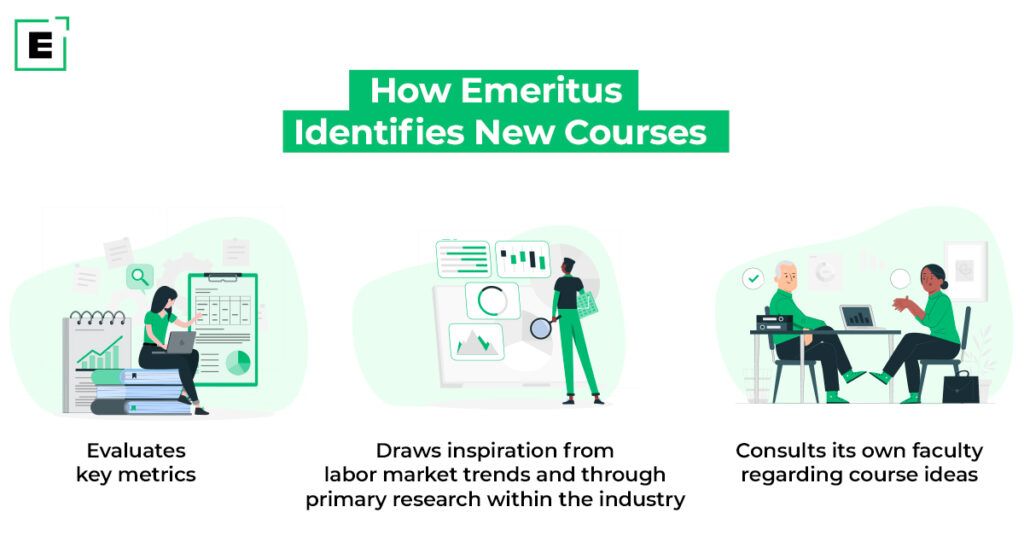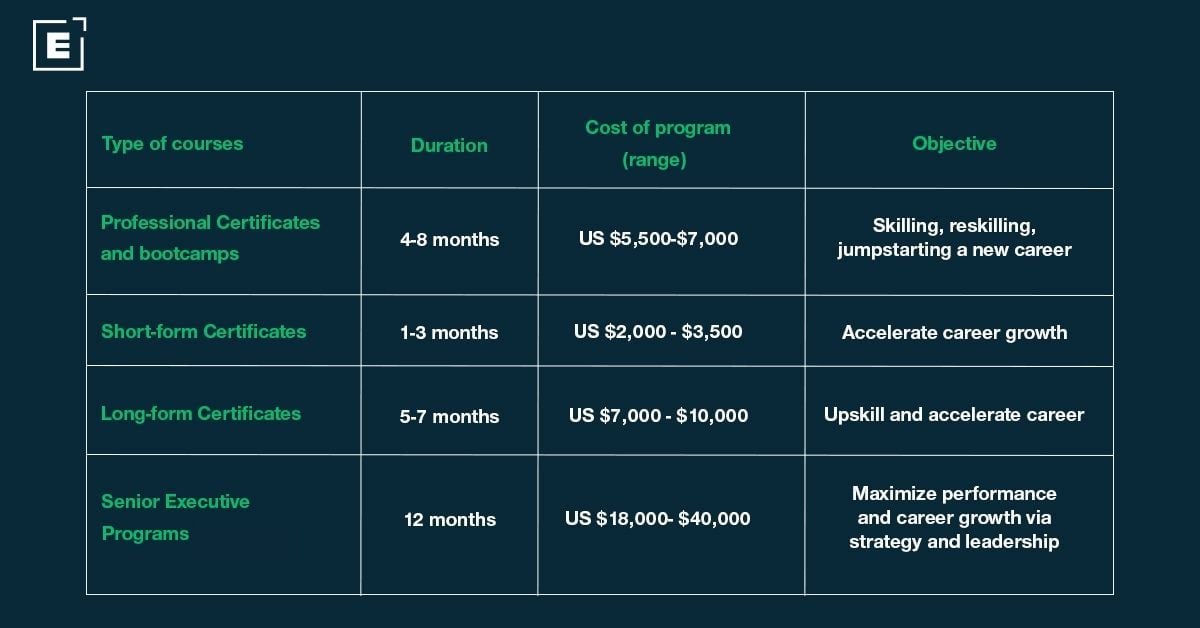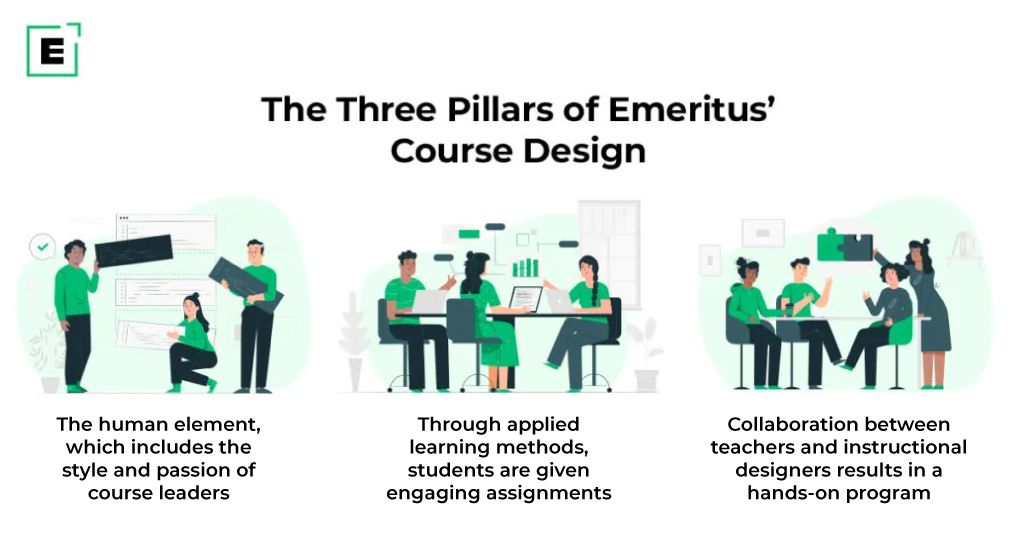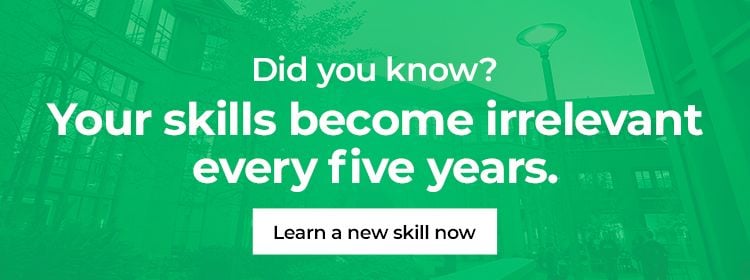How Emeritus Courses are Designed and Why It’s the Mark of Quality

Emeritus courses have an 80% completion rate. Surprised? So are most people, since the average completion rate for online courses globally is as low as 13%. This begs the question, what about our courses keeps learners so engaged till the end? We’re letting the cat out of the bag here. Discover how our courses are designed that sets it apart.
Step #1: Identifying the Right Courses to Build
“Our market research and product development team is continuously looking for the next big thing or essential skills to develop in the market.”
– Lisa Brem, Director of Design at Emeritus
 The idea is to identify a knowledge gap in the market and come up with a program to bridge this. For instance, by 2025, it is expected that the time spent by humans and machines on current tasks will be equal. This will result in 97 million new roles for machine learning experts as the division of labor between humans, machines, and algorithms grows. Naturally, the world needs a workforce educated in machine learning. Thus, we have a wide range of Emeritus courses for machine learning and artificial intelligence as part of our offerings.
The idea is to identify a knowledge gap in the market and come up with a program to bridge this. For instance, by 2025, it is expected that the time spent by humans and machines on current tasks will be equal. This will result in 97 million new roles for machine learning experts as the division of labor between humans, machines, and algorithms grows. Naturally, the world needs a workforce educated in machine learning. Thus, we have a wide range of Emeritus courses for machine learning and artificial intelligence as part of our offerings.
“Inspiration is drawn from labor market trends like job data, skill gaps, and degree conferrals. But, we also draw from primary research within the industry, such as trends and developments in business, technology, and innovation, along with interviews, surveys, and industry input.”
– Debajeet Das, Regional Director of the Product Team
So the idea for a new Emeritus course could come from anywhere as long as it is a great idea that has the potential to create impact. In fact, even faculty members who work closely with the product team to build courses make recommendations. The dialogue with faculty members about course ideas sometimes opens up avenues that were not considered before. The entire process of starting a new course is both organic and symbiotic for the world class universities we are partnering with.
 Step #2: Determining the Type and Format for the Course
Step #2: Determining the Type and Format for the Course
Once the subject is decided, the next step is to select its format. Moreover, the format must compliment the subject and suit the online learning aspect of Emeritus courses. Director of Design, Brem, sorted course formats into five categories:
- Short-form certificates: Six to 12 modules | Learner spends 4 to 6 hours per module
- Long-form certificates: 12 or more modules | Learner spends 4 to 6 hours per module
- Bootcamps: 18-28 modules of intensive study | Learner spends 15-20 hours per module
- Senior Executive Program Online (SEPO) courses: 16 to 20 modules | Learner spends 4 to 3-5 hours per module
- Electives: These are extra courses that learners opt for | Learner spends 4 to 6 hours per module
Step #3: Building the course content

“Once we start working with faculty, we integrate insights from these three pillars for a unique learning experience: the human element, applied learning, and collaboration between faculty and instructional designers,” says Brem.
The Backward Design Methodology
“Backward Design (BWD) methodology is the process of designing courses by identifying learning outcomes and then working backwards.”
-Karen Mahon, Director of Design at Emeritus
Mahon introduced the concepts of BWD methodology to Emeritus courses. In fact, it gives Emeritus courses a unique advantage over other learning platforms, and it gives learners proper learning outcomes, which makes pursuing an Emeritus course worth it.
“We identify the inputs required for the learning outcomes we have identified. This design method is effective in developing instruction for learners of all ages. Using BWD, we craft unique, interactive learning experiences that include a combination of assessments, hands-on activities, skill applications, and more,” explains Mahon.
3.1 Human Element
The “human element” of any Emeritus course entails the style and passions of course leaders. Learners receive information in small bite-sized nuggets that are easier to digest. Moreover, they receive personalized feedback to help them understand the course material and self-evaluate. Many learners have full-time jobs and personal commitments. The hybrid asynchronous/synchronous structure is made for such busy students, who learn mostly from recorded materials and attend live lectures when they can. Learning happens along side community building with their peers because networking is one of the outcomes of all Emeritus courses.
3.2 Applied Learning
“Applied learning” is a commitment that the students will be able to apply what they learn in an Emeritus course. It is the process of giving learners engaging assignments that facilitates them to understand the course material; it is a prioritization of practical application over memorizing for academic success. So, learners receive playbooks and practice simulations of real professional events that they are likely to encounter in their careers. It ensures that learners know how to handle these situations with real-life examples and case studies while also hearing industry perspectives.
3.3 Collaboration
Collaboration delivers the important content at the core of each course. Emeritus partners with the upper echelon academic minds and drives best practices in instructional design to build unique and usable courses. In fact, these Emeritus courses include engaging videos with high production value purely to make the learning experience smoother. This includes a learner-centric UX including a 24-hour live support and badges for high achievers.
Brem sums it up beautifully by saying “In the 25 weeks that follow, we focus on crafting a course that adds value to a learner’s professional life by aligning their learning goals with all the elements in the course.”
Step 4: Quality Matters
The success of the designing process for an Emeritus course does not end with designing a course. There are rigorous checks in place to ensure that the quality of education imparted to learners is top-notch. To ensure that there is no compromise in quality, all Emeritus online courses follow Quality Matters rubrics and standards. This, in turn, provides a certification of quality that ensures all courses deliver what they promise to learners — well-conceived, well-designed, well-presented courses and programs.
Lisa Brem spoke further about the rigorous quality standards required by Quality Matters to help learners upskill or reskill. “Quality Matters is a global organization that focuses on providing quality standards for online and innovative digital teaching and learning environments,” she says.
Now that you know how Emeritus courses are designed, you must be wondering how to choose the right course for you. So, find an Emeritus course that fits your learning and upskilling needs today.
Write to content@emeritus.org for content collaborations.





